Is the Film Capacitor a Discontinued Mdel?

Is the film capacitor in the process of becoming a victim of technical progress or is it a case of a passive electronic component which, when considered superficially, just runs the risk of being underestimated more easily than others, it nevertheless still holds potential for the future? This topic is to be treated in the following text from the point of view of a film capacitor specialist.
Is the film capacitor a victim of RoHS?
This is alarming and, at the same time, the provocative question was found some time ago as a headline in a well-known weekly electronic magazine [1]. It was the title of a short column, which was part of a discussion forum on "Passive Components" with 11 participants. Only two of the participants came from the manufacturing side, the others were representatives of well-known distribution companies. The content of this forum did not even deal with the topic of possible competitive component technologies and their future prospects, but rather with questions of a more general nature, e.g. further economic prospects for the year 2005, delivery times, prices, the influence of the topics RoHS and WEEE on buying behavior, China as a market or producer and many other things. Is the Film Capacitor a Discontinued Model?
That the film capacitor of all things should have received a particularly negative headline in this connection, did not seem quite plausible. The topic “RoHS victim” was extended by the skeptical question as to whether the film capacitor had even kept up with the technical development of recent years. The quint-essence summarized in a few words: the film capacitor is not only the future victim of the RoHS directive but, furthermore, a veteran among passive components, especially capacitors, which has long since missed the boat in technical progress. The opinion of the participants in the discussion was divided on this subject. Whilst one participant specifically stood up for the development capability of the film capacitor and for the fact that, in certain applications, there was, for him, no substitute as far as quality was concerned, others believed that, because it was a through-hole device and too expensive, it could be replaced by ceramic components, or that the SMD version of the film capacitor would not stand up to the higher soldering temperatures necessary to comply with the RoHS changes. After this statement from the distributor's side, only one of the two manufacturers, who “also” produces film capacitors, commented: “We are not pushing ahead with the SMD film capacitor, we favor MLCCs in this connection.” The other manufacturer, who also produces film capacitors among other things, chose to remain silent about this controversial topic.
It was certainly regrettable that no representative of the film capacitor specialists took part in the said discussions and that certain arguments were, therefore, left unsaid. This article is intended to put this right.
Film capacitors and technical development
First, it should be made clear that RoHS is not the expression of technical progress itself, but, at the most, the expression of progress in the framework of environmental protection. The aim of RoHS is the reduction of environmental pollution by poisonous substances which are contained in electronic scrap. Especially, for this reason, electronic components, circuit boards, and soldering substances are, in the future, to be lead-free.
As far as the material used for its construction is concerned, being lead-free poses no problem for the film capacitor, in contrast to certain other types of capacitor. At the most, the higher temperatures required by the RoHS conversion due to the necessity of using lead-free soldering material can cause problems for SMD film capacitors made of PET, as they are subjected to the temperature stress of the soldering process all over the surface. For the majority of film capacitors, about 80-90%, which are still produced in the through-hole form, this poses absolutely no problem. Therefore the sweeping question “Is the film capacitor a victim of RoHS?” It is not only incorrectly put, but also completely nonsensical.
But even for SMD film capacitors, whether in the wound or stacked technology, whether bare or with protective encapsulation, the solutions have long since been found in the form of heat-resistant plastic dielectrics: the capacitor films PEN and PPS which have been commercially available for years.
By using heat-resistant plastic dielectric film, SMD film capacitors make a contribution to technical progress even within the context of RoHS. On the other hand, it is questionable whether the MLCC is completely able to do so. It may consist of dielectric material which basic-ally cannot melt, but, due to RoHS, it is subject to an increased crack risk compared to previously, due to greater temperature stress occurring during and immediately after the soldering process. The general indication that the film capacitor may have lost ground to the MLCC because of the latter's smaller structure and even cheaper prices, is not necessarily the result of some sort of technical progress whatever its nature may be, but rather the result of global pressure on costs and prices. The consequence and integral part of technical progress is, however, progressive integration. Applications for all standard capacitors, whether film capacitors or MLCC, whether through-hole or in the SMD version, have fallen victim to this integration.
The question remains as to whether the acknowledged superior quality of the film capacitor as compared to other capacitors with other technologies, e.g.regarding the temperature drift of the MLCC, is not also an integral part of technical progress or may at least be considered as contributing to it. The proof that the film capacitor is not an antique, outdated product, but rather offers, even in the future, a solution for every demanding application in the framework of modern developments, is to be provided in the following comments with reference to the diverse range of articles produced by the film capacitor manufacturer WIMA.
WIMA SMD capacitors in accordance with RoHS 2002/95/EC
WIMA SMD capacitors with PEN or PPS dielectric are designed for lead-free soldering processes and can be processed at increased temperatures.
With size codes, 1812,2220,2824,4030,5040 and6054, capacitance values from 1000 pF through 6.8uF, and voltage range from 63 VDC through 1000 VDC they cover nearly the entire application range of conventional through-hole plastic film capacitors. All WIMA SMD series is produced with the proven box technology (illustration 1), showing the following advantages in comparison with non-encapsulated or molded SMD capacitor versions:
∎Safe protection of the capacitor element against mechanical and thermal stress during processing and operation. When using more temperature-resistant dielectrics like PEN or PPS an even larger safety margin than with not encapsulated parts is obtained.
∎No danger of internal cracks or tearing away of the contacts due to construction elasticity.
∎No danger of delamination due to solder plates over the capacitor's entire end surfaces.
∎The flame-retardent plastic case according to UL 94 V-0.

Fig.1 WIMA SMD capacitor with box encapsulation
WIMA subminiature capacitors in PCM 2.5mm
WIMA plastic film capacitors in PCM2.5 mm are available in metalized, self-healing versions or as pulse duty film and foil capacitors(illustration 2). As a dielectric, polyester, polypropylene, or mixed film (replacement for obsolete polycarbonate) is used. The capacitance range includes values of 100 pF through 1.0 uF and voltage ratings of 50VVDC through 400VDC.
The realization of the smallest through-hole film capacitors in the world has been made possible by the use of ultra-thin polyester films in thicknesses of8/1000 mm and below. Film processing with highly sensitive machines requires a high degree of experience and technical know-how.WIMA capacitors in PCM 2.5 mm are outstandingly suitable for HF decoupling in the field of high frequencies and open up new possibilities for use in through-hole applications with limited space requirements and high packing density.
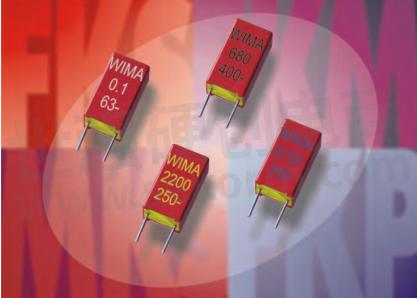
Fig.2 WIMA capacitors in PCM 2.5 mm
WIMA miniature capacitors in PCM 5 mm
∎WIMA capacitors in PCM 5 mm are available in metalized or film and foil versions with the dielectrics polyester, polypropylene, and mixed film. WIMA capacitors with a polyester dielectric (PET) are suitable for general applications such as coupling, decoupling, and by-passing.
By making use of ultra thin-film it has been possible to achieve capacitance values up to 10 µF in 5 mm PCM. The new WIMA MKS 2-HT series has been developed for operating temperatures up to +150° C, e.g.automotive electronics, lighting, or sensor equipment. The series is produced with a special, more temperature stable polyester-HT-film and features lower deviation of capacitance, dissipation factor, and insulation resistance versus temperature.
∎Polypropylene capacitors (PP) are used in the high-frequency field. This includes resonant circuits, power supplies, deflection circuits, oscillator circuits, and audio equipment. WIMA polypropylene capacitors in PCM 5 mm can also be supplied in high pulse film/foil versions with rated voltages up to 1000 VDC.
∎Mixed dielectric capacitors are used wherever linear behavior versus temperature is required. This allows the replacement of the obsolete polycarbonate capacitors in e.g. filters, memories, timers, and balancers and also in the automotive electronics and lighting industry.
WIMA capacitors for stringent requirements PCM 7.5 to 37.5 mm
WIMA capacitors for demanding requirements cover a wide range of capacitances and voltages and are available with polyester, polypropylene, or mixed film dielectrics as metalized or film and foil types. For metalized capacitors, a thin metal coating serving as the electrode is applied to the plastic film (illustration3). This method makes it possible to produce capacitors with a very favorable capacitance/volume ratio. The WIMA MKS 4, with 220 µF/50 VDC, offers the highest capacitance rating in the WIMA range.
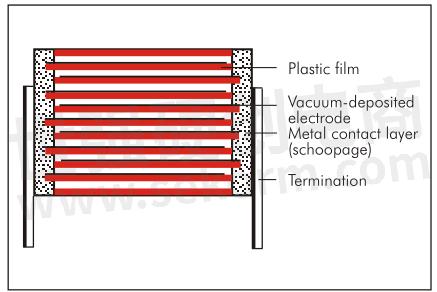
Fig.3 The internal construction of metalized capacitors
A further specific characteristic of metalized capacitors is their excellent self-healing ability. In the case of an Electric breakdown the applied metal layer evaporates (Fig. 4). The affected area is isolated and the capacitor continues to function properly.
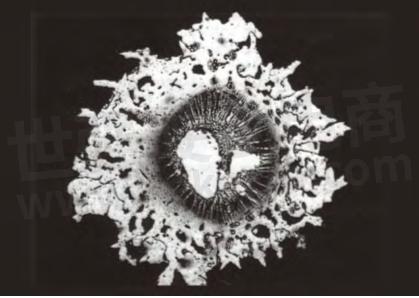
Fig.4 Microphotograph of a puncture channel
In the case of film and foil types, the electrode is not applied as for the metalized capacitors but is wound with the dielectric as a metal foil (Fig.5).
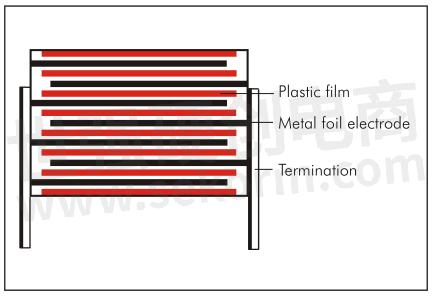
Fig.5 The internal construction of film and foil capacitors
Due to their lower series resistance, the components produced this way have an excellent pulse and current carrying capability, as well as very high insulation resistance.WIMA capacitors for stringent requirements are available with values ranging from 100 pF through 220uFwith voltage ratings from 50 VDC through 2000 VDC. The WIMA MKS 4-HT series has been developed for application temperatures up to+150° C and is produced with a special, more temperature stable polyester-HT-film. The WIMA MKS 4-LN(low-noise)has been created especially for applications with alternating load in sound-sensitive surroundings. In accordance with customer requirements, larger box sizes can be supplied as 4-lead versions. Types with terminating plates can also be manufactured on request. The advantage of this method of construction, besides the improved mechanical stability of the component on the board, is the excellent electrical contact reliability.
WIMA capacitors for high pulse ratings
An important construction criterion in the manufacture of reliable, self-healing capacitors for pulse applications is the current carrying capacity of the contacts, i.e. the connection between the terminating wires and the electrodes.
The construction principle of the series WIMA MKP10consists of a non-metalized dielectric film and a carrier film metalized on both sides acting as electrodes (Fig.6). Thanks to the metallization on both sides, the electrical conductivity is considerably improved and the contact surface between the electrodes and the school page layer is doubled. This results in better contact and allows for high current and pulse loading capability. The properties of metalized capacitors such as excellent self-healing and high volume capacitance remain unchanged.
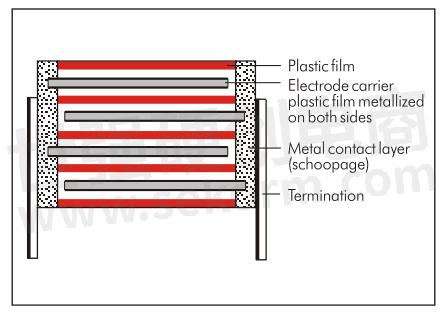
Fig.6 Internal construction WIMA MKP 10
∎The WIMA FKP 4 series presents self-healing film/foil polypropylene capacitors made from a single metalized plastic film and metal foil electrodes in a series connection(Fig. 7). This construction features a high volume capacitance and at the same time high pulse loading capability.
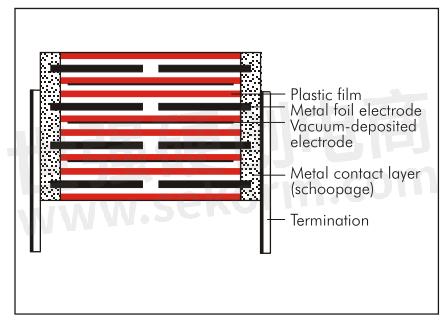
Fig.7 Internal construction WIMA FKP 4
∎The WIMA FKP 1 series was developed for extremely high pulse loads. It has an internal series connection, the metal foil electrodes being combined with a floating electrode metalized on both sides. The metal foil electrodes are safely contacted on both sides of the end surfaces. At the same time, the capacitor is fully self-healing due to the floating electrode metalized on both sides(Fig. 8). As regards pulse loading capability, WIMA FKP 1 represents the high-end capacitor technology.

Fig.8 Internal construction WIMA FKP 1
WIMA Snubber and GTO capacitors for high current ratings
WIMA Snubber and GTO capacitors are designed to attenuate voltage spikes on IGBT and GTO-Thyristors in high power conversion applications.
■WMA Snubber capacitors are pulse duty propylene capacitors with self-healing, either double-side metalized or film and foil constructions. The screw-able metal plate connections assure safe contacts at continuous high currents (Fig. 9).
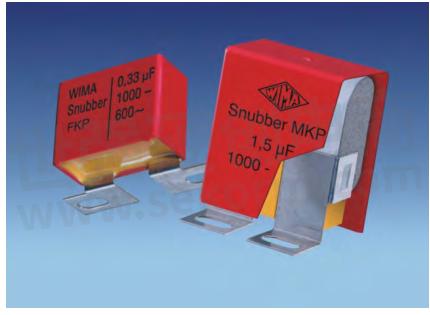
Fig.9 WIMA Snubber capacitors
■WIMA GTO capacitors are manufactured in dry-type technology with a dielectric of metalized polypropylene film and encapsulated in a cylindrical plastic case sealed with self-extinguishing polyurethane resin. The front ends have safe axial screw couplings(Fig.10). WIMA GTO MKP capacitors are available with capacitances from 1.0uF through 100 uF and with nominal voltages from 400 VDC through 1500 VDC. For mounting purposes M6 and M8 threaded terminations are possible.
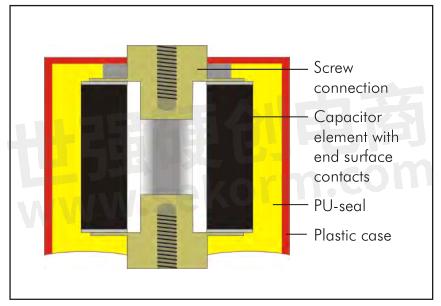
Fig.10 Internal construction WIMA GTO
WIMA RFI capacitors Radio interference suppression capacitors(Fig. 11)must not only satisfy EMC requirements in suppressing outgoing interference from an application but must also protect the application from incoming power surges.
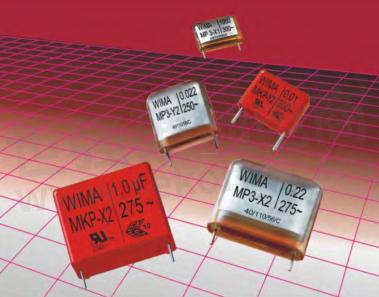
Fig. 11 WIMA RFI capacitors
There are two classes of RFI capacitors, class X and class Y.Class X capacitors are connected between phase and neutral or phase and phase conductors. Class Y capacitors have an increased degree of electrical and mechanical safety and are connected, for example, between phase conductors and earthed casing, and thus by-pass operating insulation. The specified rated AC voltage takes into account a rise of the mains voltage of up to 10% above the nominal value, in accordance with IEC 60384-14. Hence careful selection of these components is essential.
■The special feature of WIMA polypropylene RFI capacitors is the high capacitance values at smaller case sizes compared to metalized paper capacitors, being available up to 2.2 uF with AC voltages of 275 VAC and 300VAC for class X2 and Y2. Based on the dielectric used they are highly cost-effective.
■WIMA metalized paper capacitors are neither actively nor passively flammable. The components are resin impregnated under vacuum and encapsulated with self-extinguishing cast resin. Thanks to the good oxidation behavior of the paper dielectric, they have outstanding self-healing properties even with high-energy pulses. The capacitors are specified for temperatures up to 110°C and are available for classX1, X2, and Y2 applications.
Comments about WIMA
The overview of the field of film capacitors as illustrated by the WIMA range of products should make it clear that film capacitor technology has definitely kept up with the technical progress of recent years and will continue to do so in the future.
The question can be extended beyond the product itself: Does a manufacturer who specializes mainly in film capacitors still have any future at all compared to a broader one?
The answer is "yes". The firms whose strength lies in quality and which have the healthiest economy will prove to be the most steadfast and will be able to master the future. The precondition is the successful synthesis of mass producers and high-tech niche producers which is only contradictory at first sight. In the field of film capacitors, the product specialist is superior to the component all-rounder, this has always been the case and will remain so in the future, especially as far as technical advice and design-in are concerned.
WIMA still has all its production sites in Germany and therefore within the European Union and this should definitely be considered a positive factor, contrary to certain differing," up-to-date"ways of thinking.
Development in the original central area of the western hemisphere, the USA, Europe, and Japan, is coming to a head. The thrill and euphoria of globalization, the nomadic industry, and the debate about capitalism briefly characterize the wide sphere of current feeling, thinking, and discussion.
Made in Germany" is today not always made in the EU" but often only "Made under German Brand".T.he future can bring with it new aspects, even taking the global ideal of equality as a strict basis, the equality of all human beings as regards training, diligence, and productivity, I, e. it is irrelevant where or with whom one produces, for reasons of global competition it is only the lowest wage level that counts or proximity to the largest markets of the world. The last 15 years have brought more surprises and radical changes than the previous 45 years of the "cold war": the fall of the iron curtain, the reunification of Germany, the dissolution of the Soviet Union, the opening and unprecedented rapid economic development of the People's Republic of China, stock market hype and crash, the outrageous act of terror of 11 September 2001, and a total of four wars waged in this relatively short period by the leading power of the western world, the USA.
Instead of calm and peaceful worldwide development in the political and economic sectors since 1990, there have been a host of changes, upheavals, and surprises which have either been very positive or very negative and have completely broken up the world as we had previously imagined it. The economic future of the original western hemisphere is seen today with no qualms in regions that not only stood under the communist influence in the past but are still communist-ruled today. One of the most recent examples of this is Vietnam. The pursuit of even lower wage levels will logically, in the long run, certainly not halt at countries like North Korea.
China has almost completed the process of absorbing Western know-how and unrestricted technical and economic upgrading by the West and will in this respect, be able to stand on its own feet more and more. It will now noticeably demand its legitimate recognition not only as an economic but also as a political superpower of the future. Naturally, it is to be hoped and assumed that the"Chinese Dragon", the symbol of the re-strengthened Middle Kingdom, will remain tame and that the world community represented by Asia and the West will continue to work together peacefully and harmoniously.
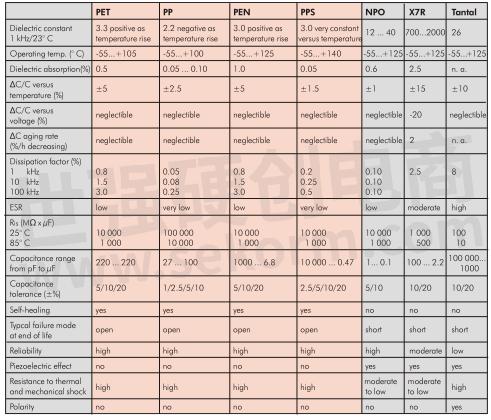
Fig.12 Comparison of different dielectrics
But it is perhaps no error or disadvantage if, alongside the companies which have already moved their main production to Eastern Europe or to Asia, there are some which believe they have good reasons not to do so and have still remained strong and competitive. Apart from the political question of how, with progressive de-industrialization, it will in the future be possible to continue to keep up the usual standard of living for over a 700million people in this original western central hemisphere, the fact remains that this region represents a relatively crisis-proof and politically stabile area for the remaining manufacturing industry. Maybe it is this, alongside the proven quality standard, which today still makes out the radiance of "Made in Germany", even in Asia.
For these reasons WIMA will retain its main location in Germany, that is to say in the EU, and will find customers nationally and internationally who appreciate this con-stellation.
Conclusion
Even if the film capacity has lost the race against the MLCC in the case of miniaturization, particularly in connection with SMT, it is still unbeatable as regards consistency, quality, and safety with comparable capacitance and rated voltage in comparison with all other capacitor technologies [2](Fig. 12).
The trend today no longer goes in the direction of further miniaturization, but rather towards large, non-impregnated film capacitors with lower and medium performance: capacitance values of several hundred microfarad and nominal voltages in the range of several thousand volts. In order to safeguard the self-healing properties of such capacitors, so-called pattern or textured metallization is being used innovatively more and more. Metalized film capacitors in the hybrid vehicles produced by a leading Japanese car manufacturer serve to absorb brake energy turned into electric energy and to back up the car battery, that is to say as an auxiliary source of energy for the electric motor[3].
This example alone should suffice to adequately document the contribution still made by the film capacitor to technical progress in many different areas.
- +1 Like
- Add to Favorites
Recommend
- New Arrival: Exxelia‘s FP 20-400-SP High Performance Power Film Capacitor with Max Power of 400KVAR
- Is the Film Capacitor a Discontinued Model?
- Exxelia Unveils Two Brand New High Temperature Film Capacitors Series Operating up to 200°c
- Exxelia to Show Latest Innovations in Film Capacitors and Magnetic Components at SIAE 2023
- Exxelia Film Capacitors Designed for Medical and Railway Applications Now Benefit from Reduced Delivery Times
- Analysis on the Application of Film Capacitors in Electromagnetic Heating Equipment
- Elevating AED Performance With Exxelia Ohmcraft Resistors & Alcon Power Film Capacitors
- EXXELIA‘s Film Capacitors Helped NASA‘s Perseverance Robot with Measuring and Sampling on Mars
This document is provided by Sekorm Platform for VIP exclusive service. The copyright is owned by Sekorm. Without authorization, any medias, websites or individual are not allowed to reprint. When authorizing the reprint, the link of www.sekorm.com must be indicated.






























































































































































































































































































































































































































































































































































































































































































































































































































































































